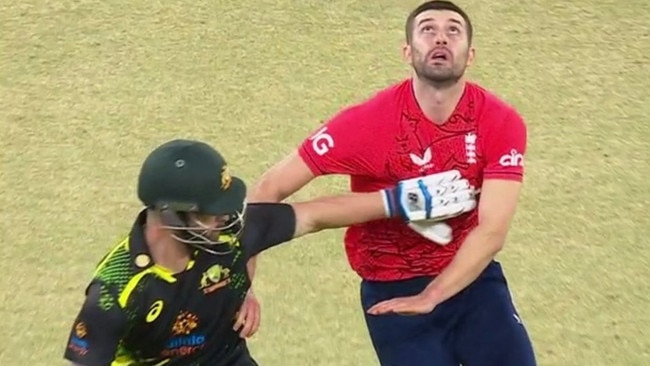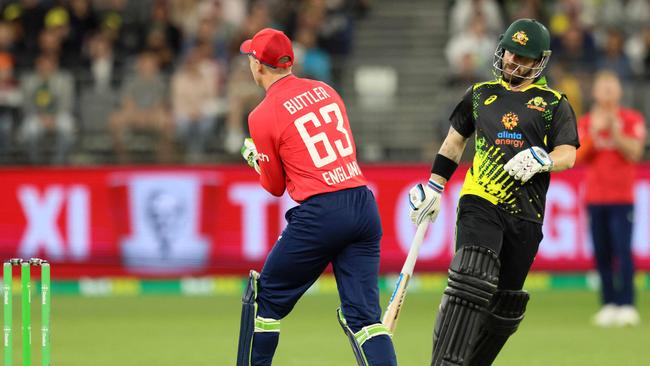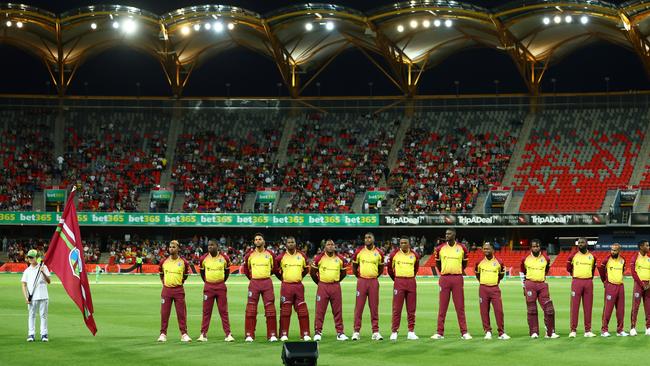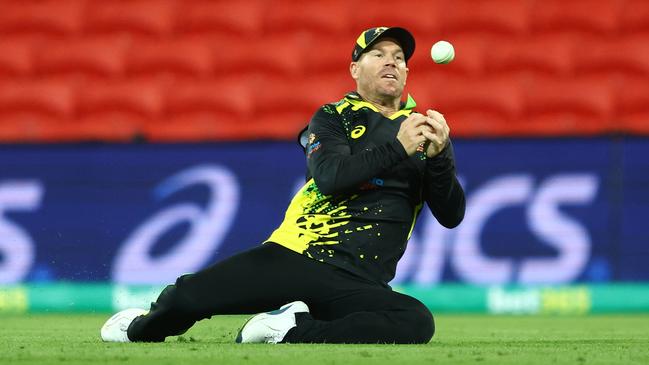Cricket 2022: Steve Harmison, England react to Matthew Wade, Mark Wood incident
England have reacted savagely to Matthew Wade’s ‘obstruction’ of bowler Mark Wood, with one of the game’s most respected voices demanding an overhaul of the rules.

Matthew Wade’s left arm has triggered the first international blow-up of the summer with angry English critics demanding changes to the rule about obstructing the field.
Former English Test fast bowler Steve Harmison has claimed English captain Jos Buttler should have confronted Wade about whether England should have appealed over an incident in the T20 match in Perth where Wade clearly obstructed the bowler Mark Wood as he tried to attempt a caught and bowled.
“I would love to have seen what would have happened if that was a final – I think Jos might have appealed,’’ Harmison said.
“If I was Buttler I would have gone up to Wade and leant on his shoulder, watched the big screen and said to Wade “what would you do in this situation because you have been here before?’’

Harmison was referring to an incident in a one-day game in 2015 when Wade appealed (successfully) for obstructing the field when Ben Stokes stopped a ball with his hand that was directed at the stumps.
Under the current laws of the game players must appeal for a decision to be given out and Buttler, fearing it would alienate hostile local crowds, elected not to do so.

England’s longest serving cricket writer Scyld Berry from The Telegraph said it was “disgraceful blot on the sport of cricket that Wade got away with blatantly obstructing the field.’’
“It was as clear a case of obstructing the field as you could ever wish not to see,’’ Berry wrote.
“The laws of cricket have to be altered. At present they state the umpire can only dismiss a batter if the bowling side make an appeal. This law has to be changed so that the umpires can intervene, as in this case, and send Wade off whether the bowling side appeaqls or not.’’
“What happens if everyone starts doing what Wade did? What happens if children in their next game of cricket stick their arm out to stop a batsman returning from the crease? Cricket crosses a vital line and becomes a contact sport.
“That is how it used to be at one point back in the 18th century.’’
SPIRIT OF CRICKET FAILS ITS BOWLERS - AGAIN
Robert Craddock
Batsman are spoiled. They always have been. And no-one is completely sure why.
We see it in the rules of the game. And it trickles into the spirit of cricket like it did on Sunday night when chivalrous – or was he calculating? - England captain Jos Buttler declined to claim Matthew Wade’s scalp for obstructing the field.
Like a frantic father trying to stop his kids from crossing a busy road, Wade shot his left arm out in front of a scrambling Mark Wood who would surely have made a routine caught and bowled.
Buttler only had to appeal and it would have been given out but thought “we’re here for a long time in Australia – it would be a risky one to go for early in the trip.’’
Solid reasoning. Nice thought. England won the game so it was a tidy- win-win.
But even Usman Khawaja tweeted “can’t believe they didn’t appeal’’ of an incident which, yet again, proved that the spirit of game has no doubt who are the kings of cricket – and it’s not the bowlers.
Can't believe they didn't appeal 🤣â˜ðŸ¾ https://t.co/wZcUuX6Z0M
— Usman Khawaja (@Uz_Khawaja) October 9, 2022
Last month in England, the spirit of cricket vibe saw Indian bowler Deepti Sharma widely lambasted for her Mankad run out of England’s Charlie Dean when the batter wandered out of her crease at the bowlers end.
So let’s get this straight.
While the spirit of cricket allows batters to wander out of their crease at will - Dean did so 72 times in that innings – before the ball has left the bowlers hand, bowlers whose back foot lands so much as one millimetre over the same crease are no-balled by the game’s electric eye.
And if a bowler transgresses that line, doesn’t get initially caught, and someone picks it up later – well … cover your ears.
Before technology evened things up a bit, one of the oldest maxims in cricket is that the benefit of any doubt always went to the batsman.
Fiery former Test leg-spinner Bill O’Reilly used to go red in the cheeks when anyone mentioned this sentence and say “can anyone give me one sensible reason why batsman get this privilege? What in god’s good name have they done to deserve it.’’

O’Reilly’s theory was that the rules of the game were made by batsman for batsman and that bowlers were the game’s pack horses.
Technology has swung things back a bit towards the bowlers … but not completely.
In video referrals there are still plenty of times when an lbw shout is given not out because less than half a ball is hitting the stump.
As former Test quick Carl Rackemann used to say “are you telling me that if less than half the ball hits the stump the bails won’t fall off?’’
There is a school of thought that cricket has never been closer to a Mankad in a major World Cup than it is in this month’s tournament in Australia.
The outrage would be instant but at least batsman cannot say they were not warned.
EMBARRASSING SIGHT CRICKET’S OWN FAULT
Cricket’s T20 World Cup has come at the perfect time to solidify the focus of a sport whose greatest rival has become itself.
Tennis, golf or any other summer rival doesn’t shake cricket’s tree in anywhere near the way cricket shakes the tree itself, sending fruit flying in all directions.
Milky schedules, awkward clashes between white and red ball games, players juggling their commitments between cashed up clubs and country, never mind their states.
Cricket is being pulled in all directions, warping in and out of shape. There is no rhythm.
The oft-changing scheduling is partially the reason why the first T20 of the summer against the West Indies on the Gold Coast attracted an embarrassingly small crowd of 4000, and the second one at the Gabba fewer than 9000.
Fans were caught off guard by the schedule change.
There was a time three decades ago when West Indian teams arriving in Queensland with the likes of Richie Richardson and Viv Richards among them would be the talk of the state.
This time, by the time people knew they were there, they were gone.

At least this month’s World Cup will bring a collective focus and shine to world cricket. All major nations in one place – Australia – at the one time.
It’s a welcome united quest for a sport in which each nation seems to have different priorities.
There’s the rich ones like England, India and Australia who still treasure Test cricket – to a point – and the poorer ones who are falling out of love with it.
And we are not talking Zimbabwe here.
In cricket’s future tours program for 2023-27 South Africa is down to play just 28 Tests – between five and six a year – instead prioritising its own T20 competition which it hopes can reignite the country’s financially stricken cricket system.
Incredibly, the five-year schedule does not include an England Test tour of the West Indies, once one of the most iconic tours in the entire schedule.
Only this year more than 10,000 English fans went to the Caribbean to watch the Test series between England and the West Indies which made Caribbean cricket around $20 million.

The cricket world is changing before our eyes.
Even the most sacred tournament of all – The Ashes – is not immune to the forceful winds of change, with five Tests being squeezed in a six-week window next June-July so England can squeeze the Hundred into the school holidays in August.
It was the ultimate sign white ball cricket is now king. The system is turning itself upside-down.
And further change is on the way. Statistician Ric Finlay this week produced a graph which showed that in 2005 there were just six international T20s. This year there have been 356 already.
There is a widespread theory in cricket that in a couple of decade’s time player primary employer will be their international T20 franchise and they will be released to play for their countries in a way European soccer players are.
It will be proof again of Bob Dylan’s famous words that money doesn’t talk, it swears. In the fast changing world of international cricket the man with the biggest wallet was never going to lose.






To join the conversation, please log in. Don't have an account? Register
Join the conversation, you are commenting as Logout